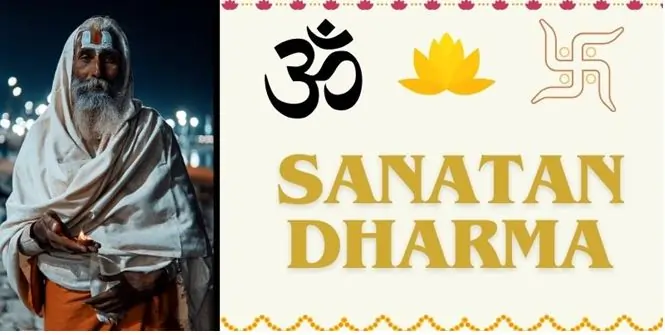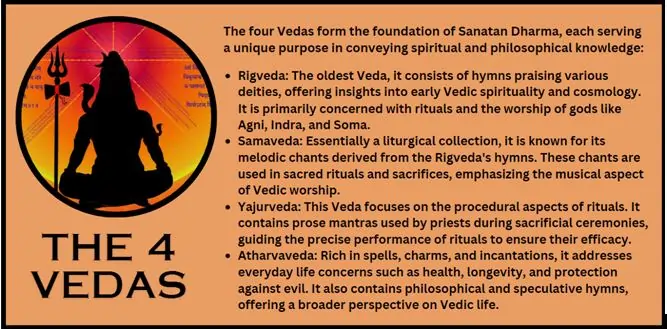
The Hindu religion is known as Sanatan Dharma or occasionally, the eternal way of life is the original name given to the Hindu religion. But it is not only a religion it is a philosophy that has remained untouched throughout millennia and has influenced millions of people.
Origins and Meaning
Sanatan Dharma is the term borrowed from Sanskrit the meaning of which is ‘Sanatan’ for eternal/ ageless and ‘Dharma’ for duty, law or righteousness. Altogether, they pose a truth which they call as the eternal truth and which is beyond the time and space, which forms the ground of existence of the cosmos. Being the oldest of all religions, the roots of Sanatan Dharma cannot be pinpointed on an individual but, rather, is traced back in history in the Vedic scriptures.Sanatan Dharma is a religion that has itsroots in the Vedic tradition of India dating back to 1500 BC. The Vedas are the sacred texts. Such texts as Rigveda, Samaveda, Yajurveda, and Atharvaveda existed and strongly contributed to providing the basis of the spiritual and philosophical concept of the religion. The Vedic period focussed more on activities of chanting, reading of hymns and offering sacrifices to various gods.
The Upanishad Era
600- 400 BCE is the Upanishads which shifted focus from ritualistic exercise to speculation. The major concepts that were formed here are Brahma and Atman; the Upanishads aims explained the nature of the world and self-realization. There was a transition to contemplative concerned beginning to overemphasize concerns and the occurrence of metaphysical musings.
The Epic Age
The Indian epics, Mahabharata and Ramayana, were produced during 400 BCE and 200 CE. These epics especially the Bhagavad Gita included in the Mahabharata became core to Sanatan Dharma. They also gave simple advice on dharma, karma and devotion in the discharge of one’s duties. The epics depicted such common Vedic believes as the duties of human, one’s honour, and submission to God.
The Classical Period
Sanatan Dharma established different schools of philosophies during the time from 200 to 1200 CE era including Masters- Advaita Vedanta, Sankhya, Yoga. This time frame also witnessed the birth of the Hindu Puranas that added to the Mytho-devotional part of Sanatan Dharma. Temples turned into religious institutions as well as places where art and culture flourished and with Bhakti saints getting involved institutions of devotion evolved along the lines of devotion to a particular deity.
Medieval Era
Sanatan Dharma also faced difficulties during the Muslim invasion and the peak of Muslim rule in India which occurred during medieval Ages. However, it keeps growing, evolving and incorporating other cultural factors into its daily practice. Bhakti saints like Kabir, Mirabai, and Tulsidas came during the period and spread the message of love irrespective of the caste or religion.
Colonial Period
With arrival of British to the sub-continents it too brought changes in terms of religious practices. It was a moment of transformation in dharma and it was the age of rebirth for Sanatan dharma and its values. Liberation movements such as those led by Raja Ram Mohon Roy and Swami Vivekananda on the issues like casteism and social taboos. This period also witnessed the Hindu awakening to remake Sanatan Dharma and the assignation of a modern avatar.
Modern Era
Sanatan Dharma as a religion still goes on in this modern world with assimilation of tradition and current culture. It has adopted modern science, technology, phenomenon, globalization and even liberal democracy. Yoga and meditation as a spiritual science is derived from Sanatan Dharma with has become popular world over and is good for health. This is because today’s world is very much in need of such principles as the philosophy promotes the involvement of all people, environmentalism as well as the fact that it upholds the universal principles of humanism.
Core Beliefs
- Dharma (Righteous Duty): Dharma is the foundation upon which life of a single person and the society is built upon. It includes obligation, entitlements, rules, behaviour, moral standards and the proper mode of life. Dharma is situational in the sense it varies with one’s age, profession, sex, and rank in society.
- Karma (Action and Consequence): Karma is an idea that states that whatever one does will happen to him in due course. Religion believes that various acts done in the current existence create the subject’s destiny in future existence; so there is always a stress on good conduct and ethical lives.
- Samsara (Cycle of Rebirth): Samsara means the cycle of birth and death, meaning when a person dies he is reborn as a new being. Sanatan Dharma simply states that the soul goes through several lives depending on its deeds it has done in previous birth. The ultimate aim is to break this cycle and attain Moksha.
- Moksha (Liberation): Moksha is the cessation of Samsara; it is what people are striving for in their lives. Also, it is the climax, where a person attains harmony with the divine, and thus ceases to reincarnate.
- Atman (Soul) and Brahman (Universal Soul): Sanatan Dharma gives the principle that ‘Atman’ and ‘Brahman,’ are certainly one, though they are described as different. Understanding this is the actual concept that has to be known for Moksha to be attained. The philosophy directs people in search of the deeper self and learning who you really are at heart.
Sacred Texts
Sanatan Dharma boasts a rich collection of sacred texts, categorized into two primary groups:
1. Shruti (Heard): These are said to be the revealed by highest divine authority. The oldest of all the 4 Vedas i.e Rigveda, Samveda, Yajurveda and Atharvaveda. They are accompanied by the Upanishads containing philosophical reflection and description of the world.

2. Smriti (Remembered): These texts are written by saints, these are famous Mahabharata and Ramayana, Pauranic text and Dharma Shashtra like Manuscript. Out of the numerous epic of Mahabharata, the Bhagavad Gita holds special place for its spiritually and philosophically guidance.
Practices and Rituals
Sanatan Dharma encompasses a wide variety of practices and rituals, catering to different aspects of life:
- Yoga and Meditation: These are basic measures to healthy physical, psychological, and spiritual state of the human body. The aim is to achieve the submersion into the one power.
- Puja (Worship): People often pray in their homes or in temples every day. This brings peace and stability in ones state of mind.
- Festivals and Celebrations: Sanatan Dharma is full of festivals, all of which are different and have different meanings and traditions; howeversome of them are Diwali, Holi, Navratra and Rakhi etc…
- Pilgrimages: Pilgrimage to Varanasi, Rishikesh and temples are part of the Hindu faith and practices or acts of penance.
Impact on Society
Importance of Sanatan Dharma is un-measurable and has shaped the Indian structure system significantly. The principles that were cultivated in it include; non-violence (Ahimsa), truth (Satya), compassion (Karuna), etc. The caste system may be ill-advised but which has its origin in the Varna system prevailing in India even today which refers to the classification of human beings on the basis of their work rather than birth.
Modern Relevance
We live in a world that has gone global, yet the principles that are professed in Sanatan Dharma are as significant now. Ideas such as yoga, meditation, and mindfulness have received global Acceptance as it improved mental and physical health. Furthermore, the fact that this philosophy upholds equality, or tolerance of all life forms, same as the values of diversity and environmentalism, embraced today.
Sanatan Dharma, the enduring method is far from being only a religion because it comprises and combines a “way of life” that can cover a variety of systems of views, and customs, including philosophy too. It provides people with one more universal approach to describe existence, meaning of the human being’s life, and the way to freedom. Through its holy scripture, prayers or the philosophical doctrines of Sanatan Dharma to this day it enlightens and directs millions towards a worthy, peaceful and a perennially contented life.
Sanatan dharma- a way of life
In the recognized conventional sense of the word, Sanatan Dharma, or Hinduism as it is often called today, is more than just a religion. Instead, it is much closer to a path or even a lifestyle where a set of principles directs believers’ choices in every sphere of their lives. Here’s a notable break down of why the Sanatan Dharma is more than just a religion, but a way of living.
Holistic Approach to Life
Sanatan Dharma, therefore, provides an all-encompassing guide to life, providing for more than the spiritual, but also moral-social-personal. Unlike some other world religions which centres its practices on worship and religious ceremonies, the practices of Sanatan Dharma weaves into daily life. This has been used to guide people on how to live righteously, how to work and play, and in general, how to live a balanced live.
Dharma: Pillar of Righteous Living
Most fundamental pillar of life. Dharma as such is not generic, it is highly situational; it differs from age, to profession, to gender and even the position occupied in the society. It also guarantees people have a reference on how they should act ethically, discharge their responsibilities and make positive impacts on society.
Self-Realization and Enlightenment
Sanatan Dharma underlines enlightenment, self-realization and knowledge. The aim of human existence is said to be to understand or experience the soul (Atman) and the self-identity or divine (Brahman). While following Sanatan Dharma all four aspects of the family and society are recognized as important parts of one’s spiritual path. The numerous phases of life (Ashramas), Brahmacharya (student), Grihastha (householder), Vanaprastha (hermit), Sannyasa (renunciant) offer a guide to personal and social improvement. Every one of those offers its own functional and moral obligations, so the individual remains progressive and content.
Inclusivity and Adaptability
The fundamental paradigm of Sanatan Dharma can be summed which by the term ‘tolerance’ or ‘ecumenism’. It does not prescribe one way to attain spirituality but multiple paths, namely, Bhakti Yoga, Jnana Yoga, Karma Yoga, etc. This flexibility of direction enables people make the decision based on personal bias or environment and therefore makes Sanatan Dharma workable for many people.
Rituals and Festivals:
Sanatan Dharma again the rituals and festivities are not mere religious activities but have communal essence. They offer time for interaction, rejoicing and remembrance within the members of the community. And events such as Diwali, Holi and Navratri are not only opportunities to pray but also opportunities to strengthen bonds in society and preserve traditions.
Ethical and Moral Teachings
Sanatan Dharma involves complete guidelines conducive for the right relationship with other people and right conduct in the society. The concepts include Ahimsa, Satya and Seva which means nonviolence, truth and service respectively. They are to be applied within people’s lives, therefore defining how people interact with other people and the society in general.